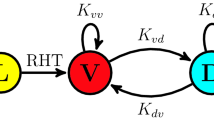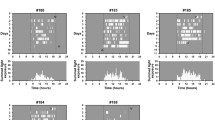Abstract
In transmeridian flights, photic and nonphotic entrainment mechanisms are expected to interact dynamically in the human circadian system. In order to simulate the reentrainment process of the circadian rhythms, the photic entrainment mechanism was introduced to our previous model, which consisted of three coupled oscillators. Regardless of flight direction, a large time difference beyond 10 h tended to induce the antidromic reentrainment. The partition between the oscillators resulted for the eastward flight over a 10-h or longer time difference and the westward over 6 h or longer. The simulated reentrainment processes almost coincided with empirical knowledge. Simulated effects of physical exercise showed that some antidromic reentrainments were switched to the orthodromic ones for the eastward flight and most of the partitions between the oscillators were prevented in the westward flight. These results are due to an augmentation of the entrainment pressure of the rest–activity cycle on the oscillators. The mechanisms underlying these various reentrainment patterns were explained based on the photic response, the interactions between the oscillators, and their adaptive modification. The simulation results suggest that an appropriate selection of departure time and physical exercise could ease the jet lag caused by transmeridian flight.
Similar content being viewed by others
References
Aschoff J (1978) Problems of re-entrainment of circadian rhythms: asymmetry effect, dissociation and partition. In: Assenmacher I, Farner DS (eds) Environmental endocrinology. Springer, Berlin Heidelberg New York, pp 185–195
Buxton OM, Copinschi G, Van Onderbergen A, Karrison TG, Van Cauter E (2000) A bezodiazepine hypnotic facilitates adaptation of circadian rhythms and sleep–wake homeostasis to an eight hour delay shift simulating westward jet lag. Sleep 23:915–927
Carrier J, Monk TH, Buysse DJ, Kupfer DJ (1996) Amplitude reduction of the circadian temperature and sleep rhythms in the elderly. Chronobiol Int 13:373–386
Hashimoto S, Nakamura K, Honma S, Honma K (2004) Non-photic entrainment of human rest–activity cycle independently of the circadian pacemaker. Sleep Biol Rhythm 2:29–36
Honma K, Honma S, Wada T (1987) Entrainment of human circadian rhythms by artificial bright light cycles. Experimentia 43: 1205–1207
Klein KE, Herrmann R, Kuklinski P, Wegmann HM (1977) Circadian performance rhythms: experimental studies in air operations. In: MacKie RR (ed) Vigilance, theory, operational performance, and physiological correlates. NATO Scientific Affairs Division, Plenum Press, New York, pp 111–132
Masubuchi S, Honma S, Abe H, Ishizaki K, Namihira M, Ikeda M, Honma K (2000) Clock genes outside the suprachiasmatic nucleus involved in manifestation of locomotor activity rhythm in rats. Eur J Neurosci 12:4206–4214
Miyazaki T, Hashimoto S, Masubuchi S, Honma S, Honma K (2001) Phase-advance shifts of human circadian pacemaker are accelerated by daytime physical exercise. Am J Physiol 281:R197–R205
Nakamura K, Hashimoto S, Honma S, Honma K, Tagawa Y (1997) A sighted man with non-24-hour sleep–wake syndrome shows damped plasma melatonin rhythm. Psychiatry Clin Neurosci 51:115–119
Nakao M, Yamamoto K, Katayama N, Yamamoto M (2002) A phase dynamics model of human circadian rhythms. J Biol Rhythms 17:476–489
Samel A, Wegmann HM (1997) Bright light: a countermeasure for jet lag? Chronobiol Int 14:173–183
Takahashi T, Sasaki M, Itoh H, Yamadera W, Ozone M, Obuchi K, Matsunaga N, Sano H, Hayashida K (2001) Re-entrainment of circadian rhythm of plasma melatonin on an 11-hour eastward flight. Psychiatry Clin Neurosci 55:275–276
Wever RA (1979) The circadian system of man. Results of experiments under temporalisolation. Springer, Berlin Heidelberg New York
Author information
Authors and Affiliations
Corresponding author
Additional information
This research was supported by a Grant-In-Aid for Scientific Research from the Ministry of Education, Culture, Sports, Science, and Technology of Japan (Nos. 14015205, 15014204, and 15560372).
Rights and permissions
About this article
Cite this article
Nakao, M., Yamamoto, K., Honma, Ki. et al. Modeling interactions between photic and nonphotic entrainment mechanisms in transmeridian flights. Biol. Cybern. 91, 138–147 (2004). https://doi.org/10.1007/s00422-004-0502-6
Received:
Accepted:
Published:
Issue Date:
DOI: https://doi.org/10.1007/s00422-004-0502-6




